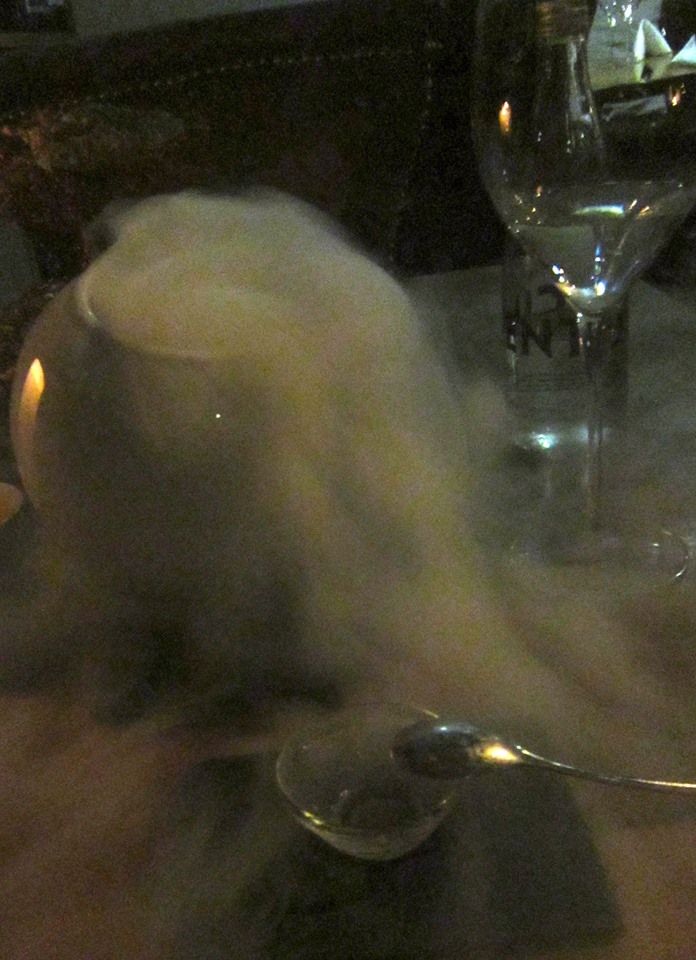The term in Spanish for contemporary experimental cuisine is “cocina de autor,” which may allude to the “auteur” theory in film and its prioritization of the director as author. The author of the meal, by analogy, is the chef, and the diner is subsumed to his, or her, vision. The preeminent autor de cocina in Colombia is Juan Manuel Barrientos, and I decided, during my stay in Medellín, to visit the original elcielo (one has since opened in Bogatá). elcielo (actually two words, “el cielo”) means “heaven” or “sky.” There are references to clouds and constellations in both the food and the décor. But, more profoundly, what elcielo is after is the celestial as sensory experience. It seeks – successfully or not – to dissolve barriers between the senses, interspersing taste with the tactile, the aural, the olfactory, and the visual.
The succession of courses at elcielo isn’t a tasting menu – it is a tasting and listening and smelling and touching and seeing menu. You cup your palms over a bowl to receive a stream of pinkish liquid, and rub them together, which turns the liquid into a kind of waxy gum. Stop rubbing, and it re-liquifies. Repeat twice and rinse with warm water. It’s a chemical reaction involving cornstarch added to rose water. I could make fun of it (maybe I have), but in all honesty, my hands have never felt so clean. A course called “Silencio” arrives in an aromatic cloud, piano music coming from under a bed of evergreen. There are cheese crisps on top, the crunchiness of which is said to “create the silence.” A copper wire bonsai of an Amazonian tree called indio desnudo is brought to the table, its crown made of yucca bread and top-browned cheese, the chewy dough a contrast to the crusty dairy.
Along the way there are wines: a surprisingly pungent Malbec rosé, a sauvignon blanc, a nice red, something sweet from Chile at the end. There’s a soup of creamy choclo (corn kernel) with a cornbread crisp. And another, of corn and red peppers, with the tail of plump, perfectly undercooked shrimp, held up by artichoke paste. After a salmon-mango ceviche with crispy onions and leche de tigre foam, a tea and ginger sorbet cleanses the palate, and a pot of liquid nitrogen tends to the nostrils, with aroma of melon. What is heaven, or the sky, without a cloud? It looks, as it disperses, like a ginni re-entering the bottle. Then poultry, chicken with squid ink, blue-cheese apple sauce, dried black olives, sugared and pulverized, followed by pork belly with brown sugar glaze, from which emanates a starburst of peanut butter and edible flowers.
The next and last protein is a medallion of beef, splattered with beet, and accompanied by dried kale, beet crisps, and cooked apple. Dessert starts with a piña colada truffle. What looks like gold leaf is actually a sparkly face paint worn at parties by Colombian children. Behind the truffle is the visual surprise of a sprig of flower. Then mango ice cream with a gravelly mix of dried frozen peanut butter and coffee, the sort of thing for which the description “scrumptious” was invented. What follows is even more amazing, so complex that the ingredients are hard to keep straight: rice paper, artichoke paste, raspberry crisps, peanut butter crumbles and some sort of ice cream.
Dessert ends with a sensory ritual. A little water is drunk to prepare the mouth. A toffee-like candy is unwrapped, without touching it, and squeezed into the mouth. Chew and keep chewing, without stopping, lest it “burn” the tongue, until it is gone. The mouth tastes of roses. Crush and rub a rose petal into your hands. It dissolves to lotion.
For information on elcielo in Medellín, click here.
